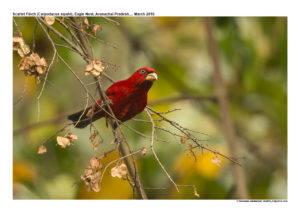Scarlet Finch

Scarlet Finch Carpodacus sipahi
Etymology:
- Carpodacus : Greek word karpos- fruit; dakos –biter { Fruit eater/biter}
- Sipahi : Hindi word sipahi- soldier
Vernacular Names: Lepcha: Phanying-pho-biu, Bhutia: Labbia-mapho
Distribution in India: Resident of Himalayas and North East India.
Description: Size of 17-18 cm. It is a medium-sized to large, large-billed and thickset finch with short wings and tail. The male has entire head, upperparts and underparts bright scarlet, lower forehead and lores slightly dusky; tail black, outer feathers finely edged bright scarlet at bases; upperwing black with edged bright scarlet edging, fine on remiges, broadly on tertials, broad edges and tips of median and greater coverts also bright scarlet; undertail-coverts have broad blackish bases finely tipped red; iris deep brown, variable; upper mandible pinkish to crimson, tinged brown, lower mandible yellowish or pale buffish-horn; legs pinkish-brown. Female has forehead to crown and nape dull olive-yellow, mottled or barred darker olive to olive-brown; upperparts dull olive, tinged paler green or olive-yellow on mantle, all feathers with fine black shaft streaks and dull greenish-olive fringes, giving scaly look, rump bright yellow, uppertail-coverts olive with yellowish fringes; tail dark brown, outer feathers finely edged olive at bases; upperwing blackish with olive fringes, median and greater coverts edged olive and broadly tipped pale buff, flight-feathers edged brownish, tertials broadly fringed pale buff-brown; lores and cheek pale yellowish-buff, ear-coverts darker or olive, streaked buffish; underparts pale grey or whitish, heavily barred or mottled darker and with blackish streaks or chevrons; bare parts much as for male. The juvenile and first-winter female resemble adult female. The first-summer male has warm rufous or light orange tinge on crown, throat and breast, orange rump patch and warm orange-buff on edges of flight-feathers. The subadult male is brightest scarlet, fading with age, but may retain olive-yellow edges of flight-feathers.
Habitat: It is found in breeding season in open montane fir and broadleaf forests, mainly along edges and clearings, at 1400–3550 m. In non-breeding season occurs more widely in undergrowth and edges of bamboo and broadleaf forests, mainly in oak down to 600 m.
Food Habits: It eats seeds, buds, berries, and occasionally small insects. It forages high in trees, where often perches conspicuously at end of dead branch; also low down in bushes, shrubs and on ground. Usually in pairs and in small groups, post-breeding flocks may be mostly of males.
Breeding Habits: They breed in May-July in India. The nest is a large or bulky cup of twigs, plant fibers, roots and grasses, placed above ground in fork of tree. It lays a clutch of 4 eggs. The incubation is done by female.